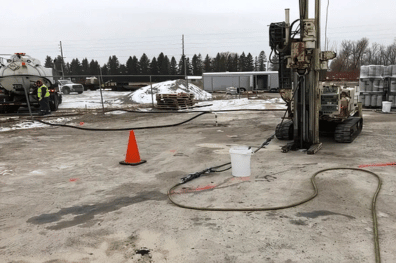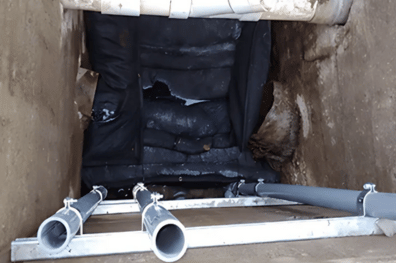ORIN conducted a pilot test to treat groundwater contaminated with PFAS using BAM, a pyrolyzed cellulosic material, via in-situ DPT injection. 4,445 gallons of BAM treatment solution was injected through 46 DPT locations. The treatment area included EW-2 and PZ-1. PZ-1C monitored the downgradient effect of the treatment area. The wells have been continuously monitored for the long term impact of BAM on the removal of PFAS from groundwater.
The Challenge
The site presented significant PFAS contamination:
- Total PFAS Concentrations:
- EW-2: 7,193 ppt (parts per trillion)
- PZ-1C: 4,499 ppt
- Specific compounds included PFOS and PFOA
- Contamination in silty sands from 8 to 2 feet below ground
- Need for both immediate and long-term treatment effectiveness
The Solution: Strategic BAM Implementation
The remediation team deployed:
- Treatment Approach:
- BAM Ultra (pyrolyzed cellulosic material)
- 4,445 gallons of treatment solution
- 46 Direct Push Technology (DPT) injection points
- Strategic placement covering source and monitoring areas
- Monitoring Network:
- Treatment area wells (EW-2 and PZ-1)
- Downgradient monitoring (PZ-1C)
- Long-term effectiveness tracking
Remarkable Results
The treatment achieved unprecedented success across multiple timeframes:
One Week Results:
- PFOS reduction: 985 ng/L to 60.6 ng/L (94% reduction)
- PFOA reduction: 94.3 ng/L to 7.33 ng/L (92% reduction)
One Year Results:
- Near non-detection levels in EW-2
- Exceeded 99% total reduction
Three Year Results:
- Maintained 86% reduction (1,011 ng/L) in EW-2
- Continued downgradient improvements in PZ-1C
- Demonstrated long-term treatment stability
Key Success Factors
Several elements contributed to the project’s success:
- Strategic injection point placement
- Comprehensive monitoring program
- Innovative BAM technology application
- Long-term effectiveness tracking
Broader Implications
This project demonstrated several crucial findings:
- BAM’s effectiveness at both high and low PFAS concentrations
- Successful treatment of source area contamination
- Reduced contaminant flux to downgradient areas
- Long-term treatment stability
- Viability for full-scale PFAS remediation
Future Applications
The success of this pilot study provides:
- Validated methodology for PFAS treatment
- Proven long-term effectiveness data
- Scalable approach for larger sites
- Solution for various PFAS concentration levels
This groundbreaking project offers a proven template for addressing one of environmental remediation’s most challenging contaminants, with demonstrated long-term effectiveness.



